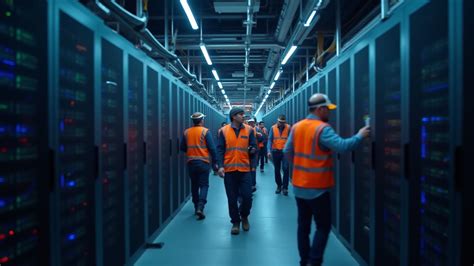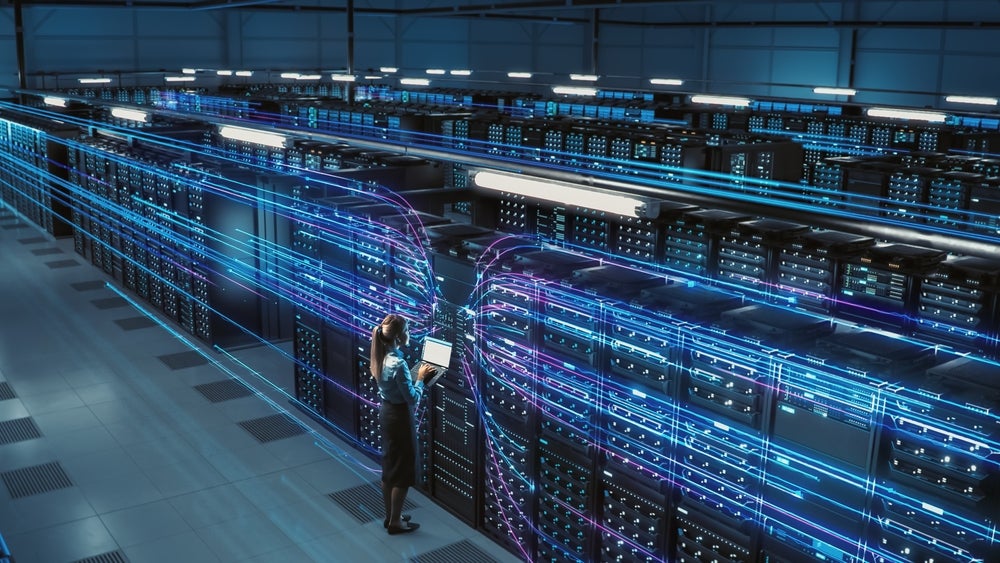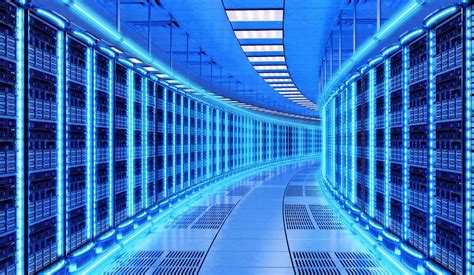The digital infrastructure underpinning our modern world is undergoing an unprecedented expansion, with hyperscale data centers at its very core. These colossal facilities, far exceeding the size and capacity of traditional data centers, are the silent giants enabling everything from cloud computing and AI development to streaming entertainment and global e-commerce. Their rapid proliferation across continents reflects a fundamental shift in how businesses and individuals consume digital services. For anyone invested in the future of technology, cloud infrastructure, or even just understanding the backbone of the internet, comprehending the growth and impact of hyperscale data centers is crucial. This expansion not only signifies immense technological progress but also presents significant opportunities for online visibility and AdSense revenue, given the high interest and technical depth of the topic. This comprehensive article will delve into the driving forces behind this global boom, explore their defining characteristics, examine their profound impact on various industries, and look ahead at the challenges and innovations shaping their future.
The Dawn of Hyperscale: What Defines These Giants?
A hyperscale data center is not merely a large data center; it’s a facility designed for massive scalability, immense computational power, and unparalleled efficiency. While there isn’t a universally agreed-upon precise definition, key characteristics distinguish them from their traditional counterparts:
A. Massive Scale: These centers typically house hundreds of thousands of servers, often spanning millions of square feet. This sheer volume allows for processing vast amounts of data and supporting millions of users simultaneously. B. Cloud-Native Architecture: They are built to support cloud computing environments, offering flexible, on-demand resources that can be scaled up or down instantly. This is crucial for services like Amazon Web Services (AWS), Microsoft Azure, Google Cloud Platform (GCP), and Alibaba Cloud. C. Extreme Automation: Hyperscale operations rely heavily on automation for deployment, management, monitoring, and even self-healing. This minimizes human intervention, reduces errors, and maximizes uptime. D. High Efficiency: Given their scale, even small improvements in energy efficiency translate into massive savings. They often employ advanced cooling techniques, optimize power usage effectiveness (PUE), and utilize renewable energy sources. E. Proprietary Hardware and Software: Leading hyperscale operators often design their own servers, networking gear, and even custom chips to achieve specific performance, efficiency, and cost targets not available with off-the-shelf solutions. F. Distributed and Redundant Design: Data is distributed across multiple facilities and geographies, ensuring high availability, disaster recovery, and low latency for users worldwide. Redundancy at every level (power, cooling, network) is paramount. G. Strategic Location: Proximity to major internet exchange points, access to abundant and affordable power (increasingly renewable), and favorable climate conditions (for cooling) are critical factors in site selection.
These characteristics collectively allow hyperscale data centers to deliver computing services with unprecedented speed, reliability, and cost-effectiveness, fundamentally altering the economics of IT infrastructure.
Driving Forces Behind Global Hyperscale Expansion
The explosive growth of hyperscale data centers isn’t arbitrary; it’s a direct response to several powerful technological and societal megatrends that demand increasingly robust and scalable digital infrastructure.
A. Proliferation of Cloud Computing
The shift from on-premise servers to cloud-based services is the single most significant driver. Businesses of all sizes are leveraging the cloud for its flexibility, scalability, and cost efficiency. This widespread adoption of Infrastructure-as-a-Service (IaaS), Platform-as-a-Service (PaaS), and Software-as-a-Service (SaaS) necessitates a global network of hyperscale facilities to host these services. Companies like Netflix, Spotify, and Salesforce rely entirely on hyperscale providers to deliver their services globally without managing their own massive server farms.
B. Explosion of Data Generation and Consumption
We live in a data-driven world. Every click, stream, social media interaction, and IoT device generates vast amounts of data. This exponential increase in data requires enormous storage and processing capabilities.
- Big Data Analytics: Businesses are increasingly using big data to gain insights, personalize experiences, and optimize operations, demanding powerful computational backbones.
- IoT Devices: The billions of connected devices (smart homes, industrial sensors, wearables) are continuously transmitting data, creating a massive influx that needs real-time processing and storage.
- 5G Network Deployment: The rollout of 5G promises ultra-fast speeds and low latency, enabling new applications (like augmented reality, autonomous vehicles) that will generate even more data and require edge computing capabilities closer to users, often relying on smaller, distributed hyperscale nodes.
C. Rise of Artificial Intelligence (AI) and Machine Learning (ML)
AI and ML models require immense computational power for training and inference. Hyperscale data centers are uniquely positioned to provide the specialized hardware (like GPUs and TPUs) and scalable infrastructure needed for these demanding workloads. The continuous development and deployment of AI-powered applications, from natural language processing to predictive analytics, directly fuels the demand for hyperscale capacity.
D. Streaming Media and Online Gaming
The global shift towards on-demand video streaming (e.g., YouTube, Disney+, TikTok) and immersive online gaming (e.g., Fortnite, Genshin Impact) consumes vast amounts of bandwidth and requires low-latency content delivery networks (CDNs) that are typically hosted within or closely integrated with hyperscale data centers. This ensures a smooth, high-quality user experience regardless of geographical location.
E. Enterprise Digital Transformation
Traditional enterprises are undergoing massive digital transformations, migrating legacy systems to the cloud, adopting new digital tools, and embracing data-driven decision-making. This migration path necessitates robust, scalable, and secure cloud infrastructure provided by hyperscale operators.
F. Global Connectivity and Localization
As businesses expand globally, they need data centers strategically located closer to their users to reduce latency and comply with data residency regulations. This drives the expansion of hyperscale facilities into new regions, including emerging markets in Southeast Asia, Africa, and Latin America.
The Global Footprint: Where Hyperscale is Expanding
The expansion of hyperscale data centers is a truly global phenomenon, with major cloud providers establishing vast interconnected networks spanning continents.
A. North America: Remains the largest market, particularly the US (Northern Virginia, Oregon, Iowa, Texas, Arizona), acting as a hub for innovation and early adoption. Canada is also seeing significant investment. B. Europe: Key regions include Ireland (Dublin), the Netherlands (Amsterdam), Germany (Frankfurt), and the UK (London). Data sovereignty and GDPR regulations play a significant role in localization efforts here. C. Asia-Pacific: This region is experiencing explosive growth due to rapidly expanding digital economies and massive populations. 1. China: Driven by local giants like Alibaba Cloud, Tencent Cloud, and Huawei Cloud, serving the immense domestic market. 2. India: Significant investments by both global and local players to cater to its massive and digitally active population. 3. Southeast Asia: Countries like Singapore, Indonesia, Malaysia, and Thailand are becoming critical hubs due to their growing digital economies, strategic location, and developing connectivity. 4. Australia: A mature market with strong growth, particularly in major cities. 5. Japan and South Korea: Highly developed markets with advanced digital infrastructure and high demand for cloud services. D. Latin America: Emerging markets like Brazil, Mexico, and Chile are seeing increased investment as cloud adoption grows and digital transformation accelerates across the region. E. Africa: While still nascent, countries like South Africa, Kenya, and Nigeria are becoming new frontiers for hyperscale development, driven by increasing internet penetration and mobile-first economies.
This geographical diversification is driven by the need for lower latency, data sovereignty compliance, and tapping into new, underserved markets with immense growth potential.
Impact on Industries and Society
The pervasive growth of hyperscale data centers is not merely an infrastructure trend; it’s a transformative force reshaping industries and society at large.
A. Economic Impact and Job Creation
Building, operating, and maintaining hyperscale data centers requires massive investment and creates a wide range of jobs, from construction and engineering to IT operations, security, and specialized technical roles. They also foster a broader ecosystem of supporting industries and services. These facilities often represent significant foreign direct investment for host countries.
B. Energy Consumption and Environmental Concerns
The immense power demands of hyperscale data centers pose significant environmental challenges. They consume vast amounts of electricity, contributing to global carbon emissions if powered by fossil fuels. This has led to a strong push for:
- Renewable Energy Adoption: Hyperscale operators are major purchasers of renewable energy (wind, solar) through Power Purchase Agreements (PPAs) to power their facilities.
- Energy Efficiency Innovation: Continuous R&D into more efficient servers, advanced cooling technologies (like liquid cooling, immersion cooling), and optimizing PUE is paramount.
- Water Usage: Some cooling methods consume large quantities of water, raising concerns in water-stressed regions. Innovation in water-saving cooling solutions is critical.
C. Data Sovereignty and Regulation
The global expansion of data centers brings complex regulatory challenges related to data sovereignty (where data is stored and processed) and privacy (like GDPR in Europe or specific national data protection laws). Hyperscale providers must navigate a fragmented regulatory landscape, often requiring them to build local data centers to comply with these rules.
D. Technological Innovation
The demands of hyperscale operations push the boundaries of technological innovation in areas like:
- Server Hardware: Development of more powerful, energy-efficient, and specialized processors (CPUs, GPUs, custom ASICs).
- Networking: High-speed, low-latency optical networking, software-defined networking (SDN), and new interconnection technologies.
- Cooling Systems: From traditional air cooling to advanced liquid cooling, free cooling (utilizing outside air), and even immersion cooling, which submerges servers in dielectric fluid.
- Automation and Orchestration: Sophisticated software platforms for managing vast, distributed IT environments with minimal human intervention.
E. Enhanced Digital Services and Innovation Ecosystems
By providing affordable, scalable, and reliable computing power, hyperscale data centers democratize access to advanced technologies.
- Start-up Empowerment: Small businesses and startups can leverage hyperscale cloud services without massive upfront infrastructure investments, fostering innovation.
- Research and Development: Researchers gain access to computational resources for complex simulations, AI training, and data analysis previously only available to large institutions.
- Global Connectivity: Seamless digital services across borders become possible, enabling global collaboration and commerce.
Challenges and Future Trends

Despite their impressive growth, hyperscale data centers face a number of significant challenges and are continuously evolving.
A. Energy Demand and Sustainability
The increasing energy footprint remains a top concern. Future efforts will focus on:
- Net-Zero Operations: Achieving carbon neutrality through 100% renewable energy sourcing and carbon capture technologies.
- Heat Reuse: Exploring innovative ways to capture and reuse waste heat generated by data centers for heating local communities or industrial processes.
- Direct Liquid Cooling: Wider adoption of direct liquid cooling, which is far more efficient than air cooling, allowing for denser server racks.
B. Supply Chain Resilience and Global Geopolitics
The reliance on complex global supply chains for hardware and components, coupled with geopolitical tensions, poses risks. Future strategies will emphasize:
- Diversified Supply Chains: Reducing dependence on single regions or manufacturers.
- Local Manufacturing: Increased investment in domestic or regional manufacturing capabilities for critical components.
- Cybersecurity: Protecting these critical infrastructures from sophisticated cyber threats becomes increasingly vital.
C. Edge Computing Integration
As latency becomes ever more critical for applications like autonomous vehicles, AR/VR, and smart cities, a hybrid architecture combining large hyperscale facilities with smaller, distributed edge data centers closer to data sources will become standard. Hyperscale facilities will serve as central processing hubs, while edge centers handle real-time local processing.
D. Advanced Automation and AI Management
The scale of hyperscale facilities makes manual management impossible. Future trends will see:
- AI-Powered Operations: AI systems will increasingly manage and optimize cooling, power distribution, workload allocation, and even predictive maintenance.
- Self-Healing Systems: Data centers will become more autonomous, capable of identifying and resolving issues without human intervention.
- Robotics: Robots may perform routine maintenance tasks or component replacements within the data center.
E. Workforce Development
The specialized skills required to design, build, and operate these complex facilities are in high demand. Investing in education and training programs for data center technicians, engineers, and cybersecurity specialists will be crucial.
F. Modular and Prefabricated Designs
To accelerate deployment and improve consistency, hyperscale operators are increasingly adopting modular and prefabricated construction techniques, where data center components are built off-site and assembled rapidly on location.
The Unseen Engine of Our Digital World

Hyperscale data centers are the indispensable, ever-expanding engines driving our increasingly digital world. Their global proliferation is a direct consequence of the exponential growth in cloud computing, data generation, AI advancements, and ubiquitous digital services. These facilities, characterized by their immense scale, extreme automation, and relentless pursuit of efficiency, are not merely infrastructure; they are foundational pillars enabling the next wave of technological innovation across every industry. While challenges related to energy consumption, regulatory complexities, and skilled workforce development persist, the future of hyperscale data centers is defined by continued innovation. From sustainable operations and edge computing integration to AI-powered management and advanced cooling, these giants will continue to evolve, silently powering our digital lives and shaping the very fabric of global commerce and communication. For businesses and individuals alike, understanding this critical infrastructure is key to navigating and thriving in the digital age, solidifying its place as a high-value topic for targeted content creation.







